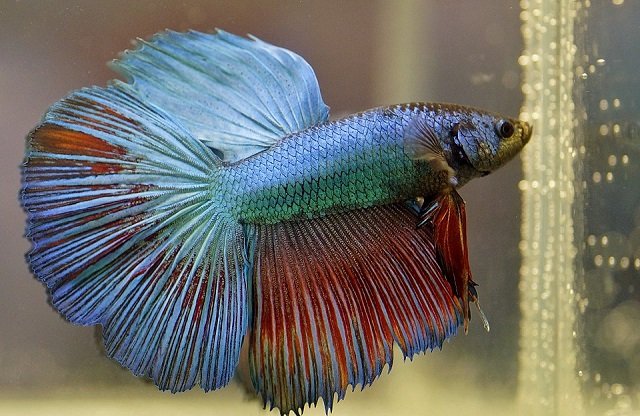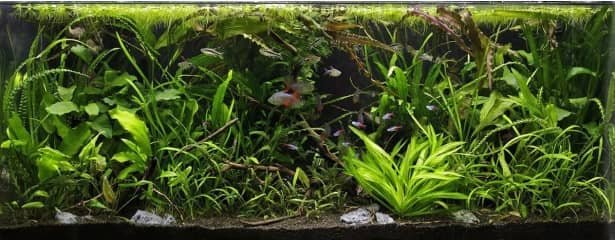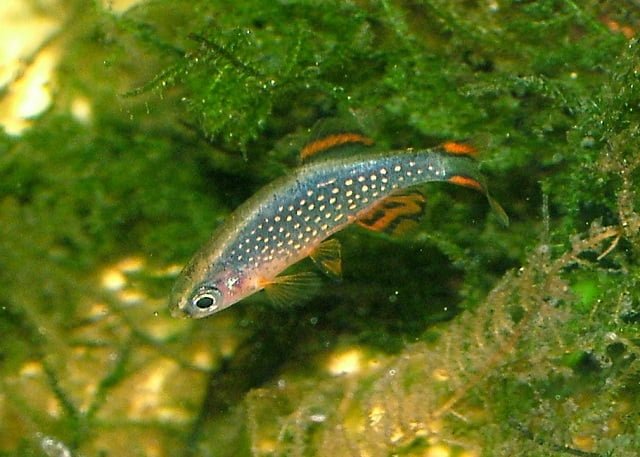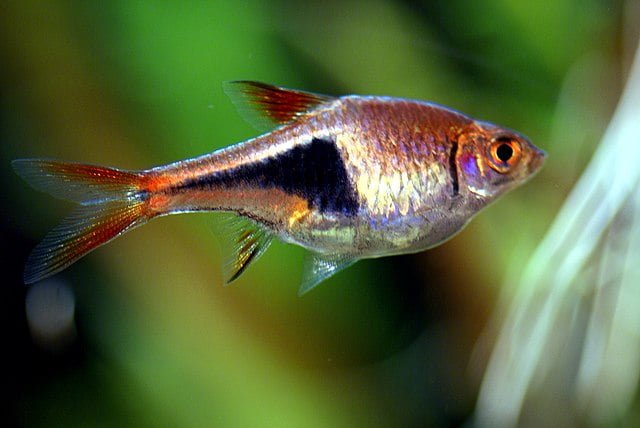
The harlequin rasbora (Trigonostigma heteromorpha) is a favorite in the aquarium world, thanks to its beauty, resilience, and peaceful behavior. These small but vibrant fish, native to Southeast Asia, are ideal for both beginners and experienced aquarists.
In this article, we will explore everything you need to know to keep your harlequin rasboras healthy and happy in your aquarium, from their size and diet to the ideal conditions for breeding. Harlequin rasboras require special care, so here’s a complete guide on how to maintain your fish healthy in planted aquariums.
Taxonomic Classification of the Harlequin Rasbora
- 1 Taxonomic Classification of the Harlequin Rasbora
- 2 Harlequin Rasbora Fish Characteristics
- 3 Natural Habitat of Harlequin Rasbora Fish
- 4 Harlequin Rasbora Feeding
- 5 Breeding Harlequin Rasbora Fish
- 6 Harlequin Rasbora Care
- 7 Compatibility of the Harlequin Rasbora
- 8 Diseases of the Harlequin Rasbora
- 9 Conclusion
- 10 References
- 11 Entradas relacionadas:
Since its discovery in 1904 by W. Duncker, the harlequin rasbora was originally named Rasbora heteromorpha. However, as of 2004, it was reclassified as Trigonostigma heteromorpha due to its name referencing the “black triangular patch” on its body.
Table 01. Taxonomic Classification of the Harlequin Rasbora.
| Kingdom | Animalia |
| Phylum | Chordata |
| Class | Actinopterygii |
| Order | Cypriniformes |
| Family | Cyprinidae |
| Subfamily | Danioninae |
| Genus | Trigonostigma |
| Species | Trigonostigma heteromorpha |
| Synonym | Rasbora heteromorpha |
| Names in Spanish | Pez arlequín, arlequín, arlequín rasbora, rasbora roja |
| Names in English | Harlequin, harlequin rasboras, red rasboras |
Fish within the genus Trigonostigma exhibit a unique breeding behavior: their eggs are deposited on the underside of broad leaves. This distinctive spawning behavior differentiates Trigonostigma individuals from those in the genus Rasbora.
The harlequin rasbora (Trigonostigma heteromorpha) is the most popular species among rasboras; however, it is often confused with T. truncata, T. espei, T. hengeli, and T. somphongsi. These fish species can primarily be distinguished by the size of the dark “wedge” (Sharpe, 2023). Hui (2020) further reports that T. truncata differs from T. heteromorpha based on several characteristics, including a gently sloping lateral head, a subsuperior mouth (rather than terminal), a caudal apex of the axine that does not reach the base of the caudal fin, dorsal and ventral apices of the axine originating posterior to the origins of the dorsal and pelvic fins, a faint brown humeral stripe, a hyaline dorsal fin base with a reddish-orange center, reddish-orange coloration in the anal fin, a bluish-lilac sheen on the body, and a shallower body depth.
The following photo presents a more detailed description by Heok (2020) of the various species within the genus Trigonostigma:
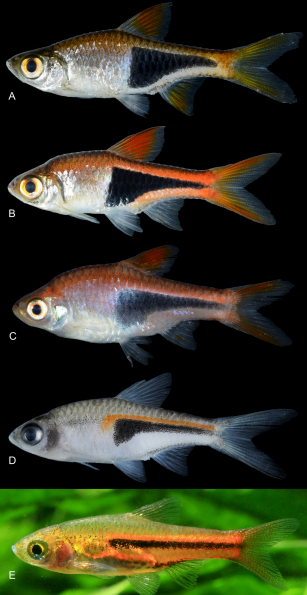
Harlequin Rasbora Fish Characteristics
Harlequin rasboras (Trigonostigma heteromorpha) possess several distinctive physical characteristics.
Stay Always Informed
Join our communities to instantly receive the most important news, reports, and analysis from the aquaculture industry.
- Body Shape: Their body has a diamond or lozenge-like shape, thicker in the torso and tapering toward the head and posterior.
- Coloration: They exhibit a base coloration that ranges from orange-pink to metallic gold or silver. They are known for having a distinctive black triangular or wedge-shaped mark that extends from the middle of the body toward the base of the caudal fin. This mark resembles the patterns of a harlequin costume, hence the name.
- Fins: The dorsal, anal, caudal, and pelvic fins have a reddish tint, with the caudal fin being forked and the red color more concentrated on the outer rays. The inner part of the caudal fin is more hyaline (transparent).
- Size: Males are slightly smaller and slimmer than females, reaching an average adult length of 4.5 cm, with a maximum of 5.1 cm. Females tend to be larger with rounder bodies.
- Eyes: They have large, round eyes.
- Sexual Differences: In addition to size and body shape, males tend to be more colorful than females. The black triangular mark may be more rounded in males and more angular in females.
It is important to note that other similar species such as Trigonostigma espei and Trigonostigma hengeli can be confused with T. heteromorpha, but they are mainly distinguished by their body shape and the shape of the black mark, which is thinner and shaped like a “lamb chop” in these species.
Differences Between Male and Female Harlequin Rasbora Fish
Male and female harlequins show slight differences in their markings. Generally, the mark or wedge is a bit larger in males (Yang, 2022). The black wedge in females is perfectly straight (Sharpe, 2023).
Additionally, female harlequins are larger than males. Mature harlequin rasboras reach an average length of 5 cm.
Lifespan
Harlequin rasbora fish have a lifespan of five to eight years. To maximize their longevity, consider these tips:
- Provide a varied and balanced diet.
- Maintain water quality through regular water changes.
- Ensure they live in a sufficiently large group to minimize stress.
- Constant monitoring of their behavior will help detect early health issues and ensure a long and healthy life.
Natural Habitat of Harlequin Rasbora Fish
The harlequin rasbora is native to Malaysia, Singapore, Sumatra, and southern Thailand (Ng y Tan, 1997; Yu et al., 2012). These fish live in streams and other watercourses characterized mainly by low mineral content and high concentrations of dissolved humic acids, as a result of the waters flowing through peat swamp forests.
The waters where harlequin rasboras live have dense vegetation and many open spaces for the fish to explore.
Harlequin Rasbora Feeding
Harlequins are omnivores, meaning they eat both plant and animal matter. In the wild, harlequin rasboras can be found grazing on algae and small invertebrates, so it is important to provide a varied diet in the aquarium.
In the aquarium, harlequin rasboras are not picky eaters, accepting a variety of foods:
- Prepared Foods: They eat flakes and pellets for tropical fish.
- Live Foods: They prefer live foods like Daphnia (water fleas), brine shrimp, mosquito larvae, and bloodworms.
- Frozen Foods: They accept frozen foods like bloodworms and brine shrimp.
- Vegetables: They can also eat blanched vegetables like lettuce, zucchini, and kale.
To ensure the good health and coloration of harlequin rasboras, it is recommended to offer a varied diet:
- A combination of prepared foods and live or frozen foods is suggested.
- Live foods like Daphnia, bloodworms, and brine shrimp are particularly good for conditioning the fish for breeding and enhancing their colors.
- Diet variety helps prevent digestive problems and reduces susceptibility to diseases.
Breeding Harlequin Rasbora Fish
To breed harlequins, you should keep a group in a single aquarium at a density of 2 males for every female. However, it is important to note that these fish do not exhibit parental care, so you must remove the parents from the aquarium once breeding is complete.
Aquarium Conditioning
The breeding aquarium should have broad-leaved plants, such as those from the Cryptocoryne or Aponogeton genus, as these are the preferred plants for harlequin rasboras to lay their eggs. Dried Cattappa leaves can also be used to simulate the natural leaf litter bed.
The water should be soft and acidic, with a hardness not exceeding 4 dGH and a pH between 6.0 and 6.5. The water temperature should be maintained between 24 and 26°C for breeding, although some sources state that 28°C is optimal. Some aquarists filter the water over peat to replicate the humic acid concentrations found in their natural habitat. The aquarium should have dim lighting.
Permana et al., (2024) successfully matured the gonads of the harlequin rasbora by administering Moina sp. enriched with turmeric and the gonadal maturation hormone Oodev.
Spawning
Harlequin rasbora fish lay eggs that adhere to the underside of leaves from plants such as Microsorium, Cryptocoryne, and Aponogeton.
The female harlequin rasbora, which should be younger than the male, swims in an inverted position under a selected leaf, rubbing her belly along the leaf in preparation for spawning. This action apparently encourages the male to join the spawning process. While the female deposits the eggs, the male releases sperm to fertilize the eggs.
A female harlequin rasbora can lay up to 300 eggs in a 1- to 2-hour period, although the average is between 80 and 100 eggs.
Egg Hatching
Fertile eggs of harlequin rasboras require approximately 18 hours to hatch at a temperature of 28°C.
After hatching, the larvae are transparent, measuring about 3 to 4 millimeters in length, and remain attached to the leaf for a period of 12 to 24 hours, during which they absorb the yolk sac.
It is important to darken the aquarium, as the larvae do not like light.
Larval Rearing
Once the harlequin larvae swim freely, they need small-sized food such as infusoria for 7 to 14 days, after which the fry can be fed with brine shrimp nauplii.
It takes approximately 8 to 10 weeks for the larvae to reach the coloration of an adult.
Harlequin Rasbora Care
When setting up an aquarium for harlequin rasbora fish, you should try to mimic their natural environment. The aquarium should have abundant vegetation and a dark substrate.

A tank for breeding harlequin rasboras should have live plants (Microsorum, Taxiphyllum, Cryptocoryne, and Anubias), but also some areas where the fish can swim freely, especially in the central part of the tank.
Harlequin rasboras require a stable and clean environment with relatively dim lighting to thrive. They are sensitive to changes in water chemistry, require adequate dissolved oxygen and ammonia levels, and need access to high-quality food.
Additionally, these fish should be kept in groups or schools of at least 8 to 10 individuals, although larger groups are preferable for the well-being of the harlequins, as they are a social species that enjoys the company of their companions.
Table 02. Parameters for breeding harlequin rasbora fish (Trigonostigma heteromorpha).
| Parameter | Range |
|---|---|
| Temperature | 22 to 28 °C |
| pH | 6.0 to 7.8 |
| Water Hardness | 0 to 15 dH |
| Nitrate Content | 50 mg/L |
| Tank Size | Minimum: 40 liters; ideal > 60 liters |
| Water Renewal (volume) | 20 to 30% per month |
| Bottom Substrate | Dark-colored sand or gravel |
Compatibility of the Harlequin Rasbora
The harlequin rasbora is famous for its peaceful and sociable nature, making it an excellent companion for other non-aggressive species. Some good tankmate options include:
- Tetras (such as Neon Tetra and Cardinal Tetra)
- Corydoras
- Guppies
- Otocinclus
- Small Barbs
- Danios
- Mollies
Avoid pairing them with aggressive or predatory fish, such as large cichlids, which may intimidate or attack them. Make sure to provide enough space for all the fish and refuge areas with plants to reduce stress.
Diseases of the Harlequin Rasbora
Harlequin rasboras do not get sick frequently and are very resilient. However, they are susceptible to diseases common to other freshwater fish.
A preventive measure is to establish a regular cleaning routine with frequent water changes to reduce the risk of diseases.
Ich
Ich is the most common disease, primarily caused by poor water conditions.
Frayed Fins
Poor water quality often causes a bacterial infection that results in deteriorated fins in harlequin rasboras.
Columnaris
Columnaris is a common disease among rasbora fish and is caused by bacteria.
Dropsy
Dropsy is a disease that causes swelling in the fish’s abdomen. You can identify it by observing your fish. An affected harlequin rasbora will have a bloated belly, pale gills, and appear lethargic.
Conclusion
The harlequin rasbora is an ideal species for community and planted aquariums as it is compatible with a variety of ornamental fish; however, this ornamental fish species is often confused with others in the same genus.
Currently, harlequin rasboras are found in any ornamental fish store, and their care is relatively easy.
References
Cheak Yi Rui Denise. 2019. Trigonostigma heteromorpha (Cyprinidae) Harlequin Rasbora. Wiki.nus
Heok Tan. 2020. Trigonostigma truncata, a new species of harlequin rasbora from Malay Peninsula (Teleostei: Danionidae). RAFFLES BULLETIN OF ZOOLOGY 68: 421–433 Date of publication: 28 May 2020 DOI: 10.26107/RBZ-2020-0058 http://zoobank.org/urn:lsid:zoobank.org:pub:776F3F8A-8323-45E2-86A0-CF9F1C7278DF
Hui, T. H. (2020). Trigonostigma truncata, a new species of harlequin rasbora from Malay Peninsula (Teleostei: Danionidae). Raffles Bulletin of Zoology, 68.
Ng, P. K., & Tan, H. H. (1997). Freshwater fishes of Southeast Asia: potential for the aquarium fish trade and conservation issues. Aquarium Sciences and Conservation, 1, 79-90.
Permana, A., Priyadi, A., Musa, A., Nur, B., Cindelaras, S., Rohmy, S., … & Budi, D. S. (2024). Induced spawning of harlequin rasbora (Trigonostigma heteromorpha) using tiger barb (Puntius tetrazona) stimuli: Techniques and outcomes. Int. J. Fish. Aquat. Stud., 12, 140-144.
Sharpe Shirlie. 2023. Harlequin Rasbora (Red Rasbora) Fish Species Profile: Characteristics, Origin, and Helpful Information for Hobbyists. The Spruce Pets.
Wikipedia. 2016. Harlequin rasbora
Yang Alison. 2022. Harlequin Rasbora Care: Size, Tank Mates, Breeding & More. Aquarium Source
Yu Abit, L., Kamaruddin, I. S., Mohd-Rozhan, Z., Ina-Salwany, M. Y., & Mustafa-Kamal, A. S. (2012). Fish biodiversity survey (2009) of streams in the Ayer Hitam forest reserve, Puchong, Selangor. Pertanika J. Trop. Agric. Sci, 35(1), 15-19.
Editor at the digital magazine AquaHoy. He holds a degree in Aquaculture Biology from the National University of Santa (UNS) and a Master’s degree in Science and Innovation Management from the Polytechnic University of Valencia, with postgraduate diplomas in Business Innovation and Innovation Management. He possesses extensive experience in the aquaculture and fisheries sector, having led the Fisheries Innovation Unit of the National Program for Innovation in Fisheries and Aquaculture (PNIPA). He has served as a senior consultant in technology watch, an innovation project formulator and advisor, and a lecturer at UNS. He is a member of the Peruvian College of Biologists and was recognized by the World Aquaculture Society (WAS) in 2016 for his contribution to aquaculture.
